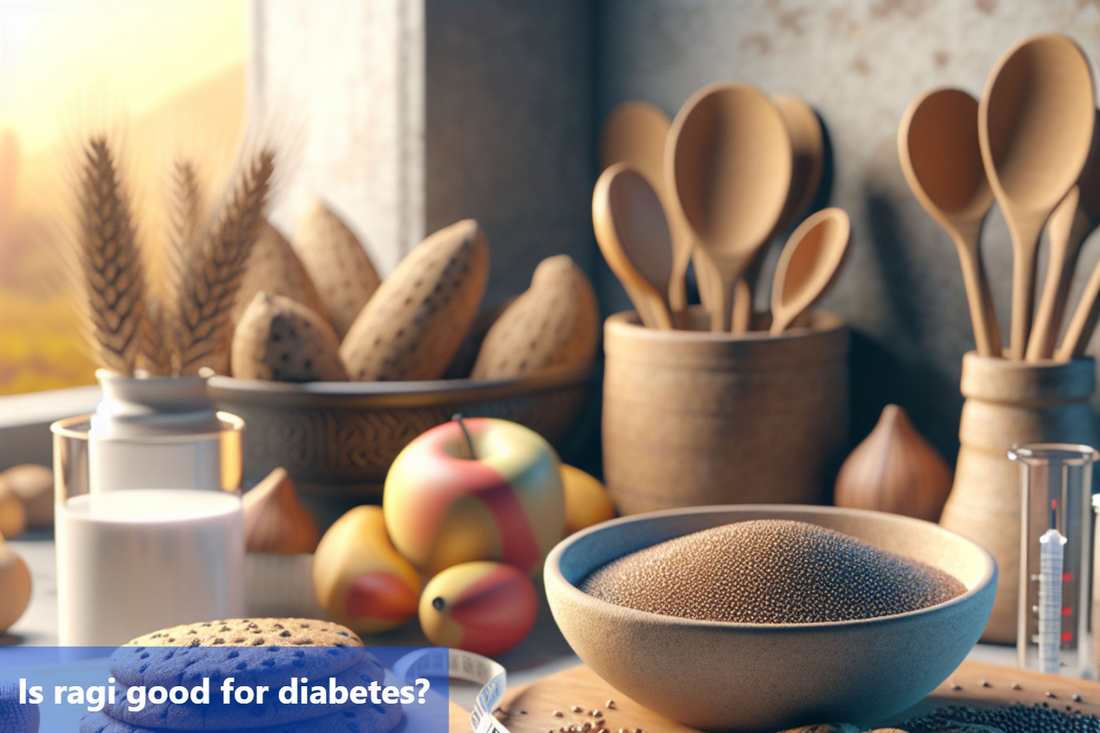Ragi, or finger millet, is a nutritious grain with health benefits, especially for those with diabetes. It is rich in fiber, protein, calcium, and iron, making it a valuable part of a balanced diet.
Ragi's high fiber content helps regulate blood sugar levels by slowing down digestion and glucose absorption, preventing spikes after meals. It also has a low glycemic index, making it suitable for diabetic individuals to improve blood sugar control.
In summary, ragi offers nutritional benefits that can support diabetes management through mindful dietary choices.
Nutritional Benefits of Ragi
Ragi, also known as finger millet or African millet, is a highly nutritious cereal grain that is widely consumed in various parts of the world, particularly in Africa and Asia. Here are some of the key nutritional benefits of ragi:
|
Nutrient |
Amount per 100g |
Benefits |
|---|---|---|
|
Calories |
336 kcal |
Provides energy for bodily functions and activities. |
|
Carbohydrates |
72 grams |
Main source of energy, including dietary fiber which aids digestion and promotes satiety. |
|
Protein |
7.3 grams |
Essential for muscle growth and repair, and helps keep you feeling full for longer. |
|
Fat |
1.3 grams |
Provides essential fatty acids and aids in the absorption of fat-soluble vitamins. |
|
Dietary Fiber |
3.6 grams |
Aids digestion, promotes bowel regularity, and helps control blood sugar levels and appetite. |
|
Calcium |
344 mg |
Essential for bone health and muscle function. |
|
Iron |
3.9 mg |
Important for the formation of red blood cells and oxygen transport in the body. |
|
Magnesium |
137 mg |
Supports muscle and nerve function, blood sugar control, and bone health. |
|
Phosphorus |
283 mg |
Required for bone and teeth formation, as well as energy metabolism. |
|
Potassium |
408 mg |
Helps regulate blood pressure, fluid balance, and muscle contractions. |
|
Vitamin B3 (Niacin) |
1.1 mg |
Supports energy metabolism, nervous system function, and skin health. |
|
Vitamin B1 (Thiamine) |
0.33 mg |
Important for energy metabolism, nerve function, and heart health. |
|
Antioxidants |
Various |
Ragi contains phenolic compounds and antioxidants which help neutralize harmful free radicals in the body, reducing the risk of chronic diseases. |
|
Low Glycemic Index |
Low |
Releases glucose into the bloodstream slowly, helping to prevent spikes in blood sugar levels. |
|
Gluten-Free |
Yes |
Suitable for individuals with gluten intolerance or celiac disease. |
Please note that these values are approximate and may vary slightly depending on factors such as variety, cultivation methods, and processing. Additionally, the nutritional content of ragi-based products may differ based on ingredients and preparation methods.
Effects of Ragi on Blood Sugar Levels
Ragi, also called finger millet, has a low glycemic index (GI). This means it slowly releases glucose into the blood, causing a gradual rise in blood sugar levels. Because of this, ragi is a good grain choice for people trying to manage their blood sugar, especially those with diabetes. Here are some ways ragi affects blood sugar levels:
-
Low Glycemic Index (GI): Ragi has a low GI, usually between 50 and 70, depending on the type and how it's prepared. Foods with a low GI raise blood sugar levels slowly, preventing sudden spikes and drops, which is good for controlling blood sugar.
-
High in Fiber: Ragi is packed with fiber, both soluble and insoluble. Fiber slows down glucose absorption, helping to control blood sugar levels and improve insulin sensitivity, which can benefit those with diabetes.
-
Protein Content: Ragi has a decent amount of protein, which can also help stabilize blood sugar. Protein slows down carb digestion, leading to a gradual glucose release into the blood after meals.
-
Insulin Sensitivity: Some studies suggest that consuming ragi could enhance insulin sensitivity, potentially improving blood sugar control in people with diabetes or insulin resistance.
-
Weight Management: Adding ragi to your diet might aid weight management, which can positively impact blood sugar levels. Maintaining a healthy weight is crucial for metabolic health and blood sugar regulation.
-
Antioxidant Properties: Ragi contains antioxidants like phenolic compounds and flavonoids, which have anti-inflammatory and protective effects. These antioxidants could decrease oxidative stress and inflammation linked to insulin resistance and diabetes complications.
-
Satiety: The mix of fiber, protein, and complex carbs in ragi can make you feel full, preventing overeating and subsequent blood sugar spikes.
Incorporating Ragi into a Diabetic Diet
Incorporating ragi, or finger millet, into a diabetic diet can offer several benefits due to its low glycemic index (GI) and high fiber content. Here are some tips for including ragi in a diabetes-friendly diet:
-
Ragi Flour: Use ragi flour as a substitute for refined wheat flour in various recipes such as rotis (flatbreads), dosas (pancakes), idlis (steamed cakes), and baked goods like cookies and muffins. Ragi flour adds a nutty flavor and enhances the nutritional profile of the dishes.
-
Ragi Porridge: Prepare ragi porridge by cooking ragi flour with water or milk until thickened. You can sweeten it with a small amount of natural sweeteners like stevia or monk fruit, or flavor it with spices like cinnamon or cardamom for added taste without significantly increasing the sugar content.
-
Ragi Upma: Make ragi upma by sautéing ragi flour with vegetables like onions, tomatoes, and green chilies. Add water and cook until the mixture thickens. Garnish with fresh cilantro and serve as a nutritious breakfast or snack option.
-
Ragi Idlis and Dosas: Combine ragi flour with urad dal (black gram) and rice to make idli and dosa batter. Ferment the batter overnight and then steam it to make soft and fluffy idlis or spread it thinly on a hot griddle to make crispy dosas. Serve with sambar and chutney for a balanced meal.
-
Ragi Khichdi: Cook ragi with lentils (such as moong dal) and vegetables to make a nutritious and filling khichdi. Season with turmeric, cumin, and other spices for flavor, and serve as a comforting one-pot meal.
-
Ragi Upma: Another option is to prepare ragi upma by sautéing ragi flour with vegetables, mustard seeds, and curry leaves. Add water and cook until the mixture thickens. Garnish with grated coconut and chopped cilantro before serving.
-
Ragi Snacks: Prepare healthy snacks using ragi, such as ragi ladoos or energy bars. Combine ragi flour with nuts, seeds, and dried fruits, and bind them together with a small amount of honey or nut butter. Shape into balls or bars and refrigerate until firm.
-
Ragi Smoothies: Add ragi flour or cooked ragi to smoothies along with other low-glycemic fruits like berries, avocado, or cucumber. Blend with unsweetened almond milk or yogurt for a nutritious and filling beverage.
Bottom Line
There are simple ways to include ragi in your meals to get the benefits. You can add ragi to your breakfast or use ragi flour for baking. These are practical tips for making ragi a part of your daily diet.
Ragi is a good choice for managing diabetes because it can help control blood sugar levels. By adding ragi to your diet, you can support your overall health and well-being if you have diabetes.
References
This Blog post is an initiative by DiabeSmart, to provide accurate and Nutritionist / Doctor approved information related to Diabetes. DiabeSmart is India's first Food brand designed specifically for Diabetics, that has been clinically tested on Diabetics and Pre-Diabetics to deliver 55% - 70% lower Sugar spikes. DiabeSmart is part of Lo! Foods - India's leading brand for Everyday Functional Health foods.















